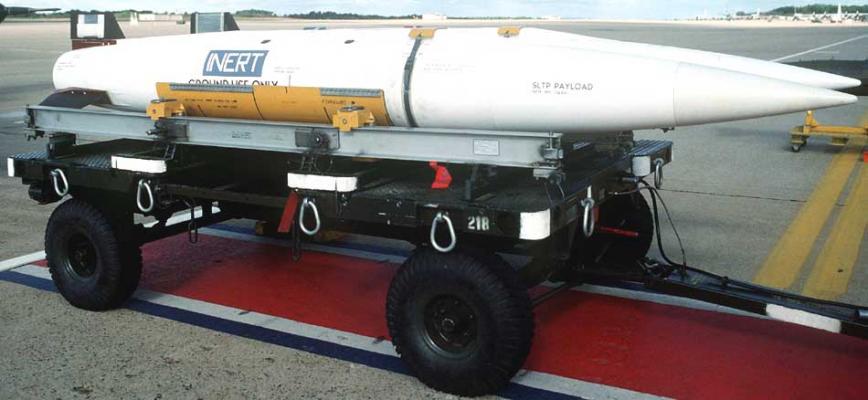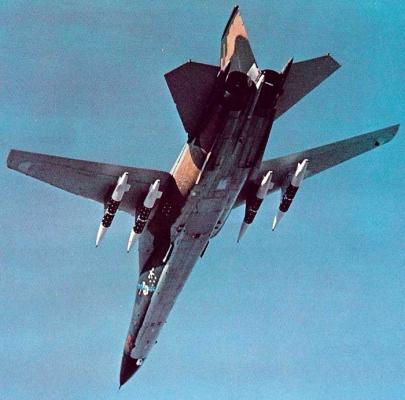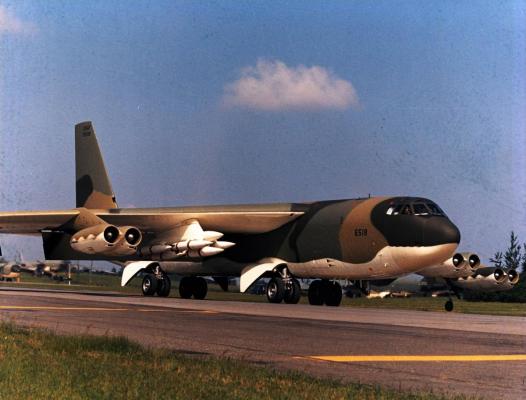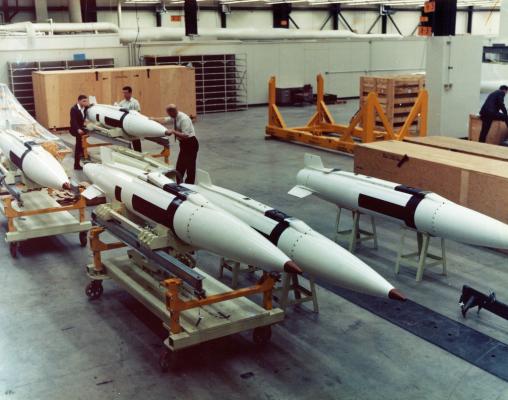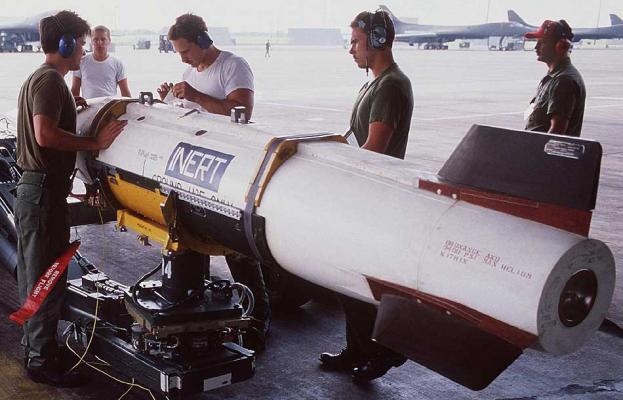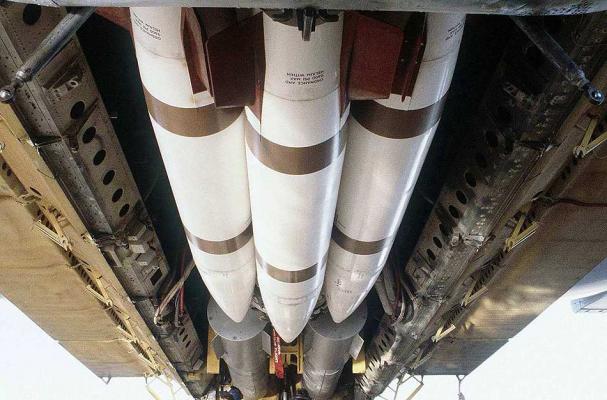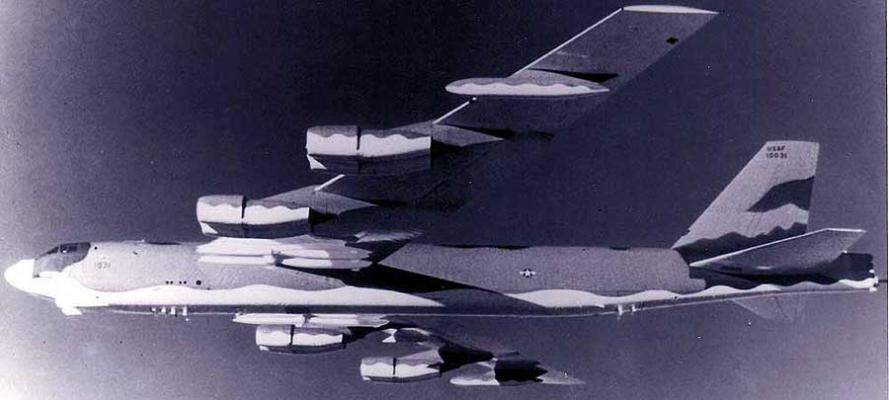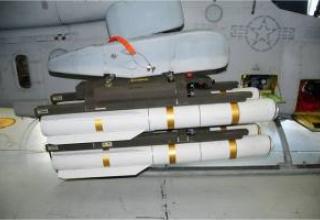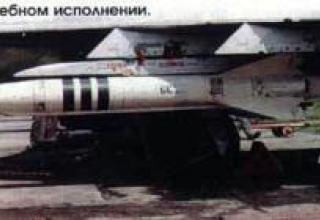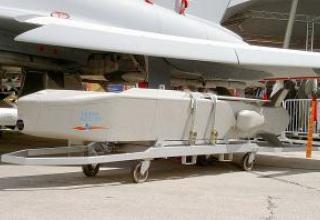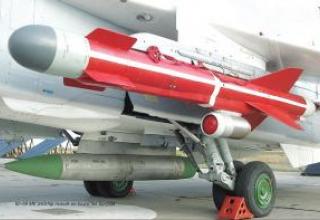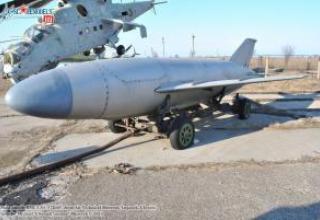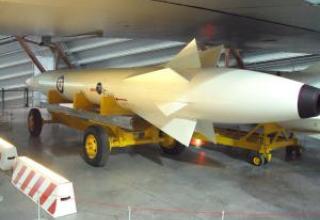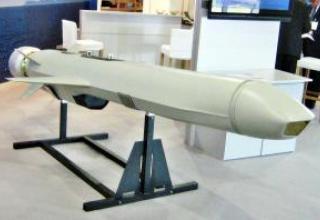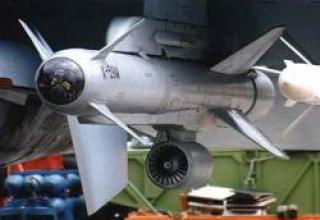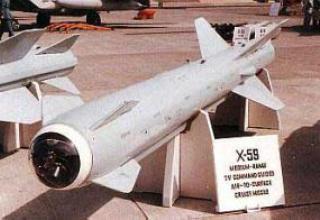The idea of creating a missile AGM-69A SRAM (Short Range Attack Missile), appeared in one of the whole set of programs of the first half of 1960s - the complex, which was aimed at improving the effectiveness of the U.S. strategic bomber aircraft in the new conditions for it to have a likely enemy (ie, first of all, the USSR) highly effective air defense forces and means, overcoming of which by the U.S. Strategic Aviation Command (SAC) aircraft was considered unlikely without unacceptable losses in equipment and personnel. The high flight altitude and high supersonic speed of the carrier were no longer sufficient conditions for successful performance of the mission. Aircraft departure to low altitudes, thus, was a forced measure of temporary character, because SAC experts were well aware that the development in the USSR of highly efficient automated anti-aircraft systems, reducing the advantage of low-altitude flight to zero, is not far off. The American experts saw two ways out of this situation. The first was the maximum reduction of combat aircraft visibility, primarily in various ranges of electromagnetic radiation, both own and reflected. However, this in itself was a very complex complex problem, which has not been completely solved to this day. The second output dictated the need to equip the existing bombers with attack tools that could either destroy the enemy's air defenses on course, or destroy the target, not entering the range of its cover air defenses, which seemed more attractive solution. At the same time, only a missile could become such a striking device. The development and deployment of air-based cruise missiles with a thermonuclear BC AGM-28 Hound Dog (two on the outer sling of each aircraft B-52 modifications D-H) and cruise missiles-target ADM-20 Quail (up to 4 pieces in the bomb compartment of each aircraft B-52 modifications E-H) allowed to partially reduce the severity of the problem of increasing the survival of manned carriers.
However, the small number of attack missiles on board one bomber and their shortcomings (large linear dimensions, liquid fuel, difficult to maintain turbojet engines and control systems) forced SAC experts to start searching for a way out of the situation, Especially since the development program of the latest strategic airborne missile AGM-48 Skybolt closed in 1962 (each B-52 modifications of G-H had to carry on the external suspension up to 4 new weapons), and Hound Dog has always been considered only as a temporary measure until the AGM-48 in service. The scientific and technical level of that time quite allowed the creation of a supersonic solid-fuel missile with a thermonuclear BC and a simple inertial control system, which would have a relatively small size and could be placed both on existing and prospective carriers in large quantities (about 10-20 pieces on a single aircraft).
The official start of work on the SRAM program dates back to November 23, 1963, when the SAC Air Force General Headquarters submitted to the Air Force General Headquarters for consideration the so-called Qualitative Operational Requirement 95 (QOR 95) with the general requirements for a prospective short-range impact missile of air-to-ground class. The General Headquarters of the Air Force, in turn, already on March 18, 1964, developed the Special Operational Requirement 212 (Special Operational Requirement 212, SOR 212) for new weapons. March 23, 1965 U.S. Defense Secretary McNamara approved the start of work on the program SRAM (Short Range Attack Missile). Its development was conducted as a "weapon system" WS-140A. October 31, 1966 was named the main contractor - it became the leading American aerospace corporation Boeing (Boeing Aerospace division). Subcontractors were Lockheed Propulsion and Thiokol Corporation (development of solid rocket engine), and the consortium of General Precision/Singer's Kearfott Division. Thermonuclear BC was developed by the Atomic Energy Commission together with Unidynamics, which was responsible for the most important parts of the BC nuclear safety systems, its platoon and subversion. The carriers of this advanced weapon were intended strategic bombers B-52 modifications G and H, as well as supersonic strategic bomber with variable in-flight wing geometry FB-111A Aardvark.
The first test missile developed under the SRAM program and designated AGM-69A was successfully launched on July 29, 1969 from a B-52H bomber aircraft over White Sands Missile Range, New Mexico. The first test launch of the AGM-69A from the FB-111A bomber took place on May 20, 1970 without comment. On January 12, 1971, as a result of the tests, the General Headquarters of the Air Force offered Boeing Corporation under a new contract to begin full-scale production of SRAM missiles. The test program ended on July 22, 1971 after 40 test launches over White Sands Test Site from the B-52G/H and FB-111A bombers. At the time of its completion, the missile's RDTT had been the most controversial topic of discussion, so it was already in April 1971 that the Ogden Air Logistics Center, Hill Air Force Base. Utah) and Air Force Systems Command (Wright-Patterson Air Force Base, Ohio), together with major contractors Boeing and Lockheed Propulsion, launched the SRAM Explosive Components Aging and Surveillance Program. All of the above participants, along with the Oklahoma City Air Logistics Center (Oklahoma City Air Logistics Center, Tinker Air Force Base, Oklahoma), Air Force Rocket Propulsion Laboratory (Edwards Air Force Base, California) and the U.S. Air Force SAC formed the SRAM Surveillance Program Working Group (SRAM Surveillance Program Working Group), a mixed force implementing the above program. Its main objective was to obtain all necessary data on the ageing processes of RTMS missiles and other pyrotechnic devices in order to reliably predict the future behavior of these technical systems and their timely replacement in order to maintain the entire weapon system in operational condition. The companies' contracts were received in June 1972 and direct work began in May 1973. Each year, the programme selected five RDTTs from the SAC arsenals in one batch for burning on special stands in various climatic conditions. Two more RDTs from the same batch were extracted from the SAK arsenals for their subsequent chemical opening in order to further test the physical and ballistic properties of the rocket fuel. For the same purposes, 6 pyrotechnic devices associated with a SRAM missile were selected from the SAC arsenals for 22 each. Typically, for the tests selected the party with the longest shelf life, taking into account the number of flight hours of the rocket on the suspension of the carrier aircraft in various conditions, and taking into account the number of cycles of "take-off and landing. Later, the number of RTDTs that were burned decreased to 4 per year, while the number of RTDTs that were opened each year increased to 3.
The first AGM-69A came to the SAC on March 1, 1972 and already on March 4 arrived at the 42nd wing of heavy bombers, armed with a B-52G (Air Force Base Loring, Maine). On June 15, 1972, the aircraft of this wing launched a serial missile over White Sands Missile Range for the first time, and already on September 15, 1972, this unit became the first wing of the SAC recognized as combat-ready for the use of new weapons. By the end of December 1972, the SAS had 227 SRAMs in its arsenals. On January 1, 1973, the 509th wing of medium bombers (Pis Air Base, New Hampshire), became the first aircraft unit with the FB-111A, which reached combat readiness for the use of these missiles. The first regular AGM-69A training and combat launch took place Jan. 9 from the B-52G over Holloman Air Force Base, New Mexico. The operation was called Bullet Blitz. July 30, 1975, mass production of AGM-69A ceased, and August 20, 1975 the last of the mass-produced missiles was delivered to the SAC - it received the 320th wing of heavy bombers, equipped with a B-52G (Air Force Base Mayzer, California). Thus, the deployment of new weapons was completed - by the end of the year there were 1451 missiles in the SAK. In total, produced 1521 pieces (for comparison - the total production of all CRs Hound Dog, Quail and Skybolt was markedly less than this number, making a total of 1355 pieces), the contract for the production of 300 additional units was canceled. The scope of the upgrades for B-52 bombers as the main carriers was so large that they were conducted in parallel with two centers - in San Antonio (B-52H) and Oklahoma City (B-52G) - to speed up the work. In 1971-1977, the so-called Modification 2126 program spent $417 million excluding the cost of the missiles themselves to upgrade the B-52 bombers alone to enable them to use SRAM.
The new missiles were also supposed to be included in the armament of the then developed supersonic heavy bomber with variable geometry wing B-1A (the program was discontinued in June 1977). According to the plans of U.S. analysts, SRAM was to organically complement and developed then under the program ALCM strategic cruise missile AGM-86 - representatives of the latest promising family of weapons launched long before the approach of the aircraft carrier to the target, "knock out" located on the route of air defense facilities, and SRAM provided defeat to the target itself. The importance of SRAM missiles in the common doctrine of SAC bombers was emphasized by the fact that since October 1978, as part of the annual Proud Shield competition held among SAC bombers, the unit with the B-52/FB-111, which scored the highest number of points on conditional launches AGM-69A, was awarded the honorary award The General Russell E. Dougherty SRAM Trophy. Additionally, as part of the annual Giant Sword combat weapons service competition, the winner unit of these missiles received the Best SRAM Load Crew Trophy. Later, in the second half of the 1980s, units equipped with B-1B bombers joined both competitions.
The development of new weapons wasn't without problems. The greatest number of complaints was caused by poor functioning of the marching solid fuel engine. There were so many problems that in 1976 Thiokol received an offer to develop a new engine for the SRAM missile. The project for the advanced missile, equipped with a new engine, an improved control system and a new thermonuclear BC W-80, was designated AGM-69B SRAM B. It was designed primarily for the promising B-1A bomber, but due to the closure of its development program and the most significant problems with the existing engine, the SRAM B program was closed in 1978. In the 70s, the AGM-69A was also considered to be equipped with a passive homing radar system to destroy enemy radars and even an active homing head to destroy air targets, but none of the options was implemented in practice.
In 1981, the program to develop a B-1 bomber was revived, but already in the form of an aircraft with reduced visibility of the B-1B Lancer. The B-1B bomber was able to carry 24 AGM-69A missiles on three rotating MPL (Multi-Purpose Launcher) drums located inside the fuselage. It was also planned to further increase the number of aeroballistic missiles on a single B-1B carrier up to 32 pieces through the use of four underwings hanging units, but these plans were not fulfilled. On January 16, 1987, for the first time, a SRAM missile was launched from the B-1B above the Tonopah Test Range, Nevada. The launch was conducted by personnel and a Special Test Unit aircraft from Edwards Air Force Base, California. On June 3, 1987, the first SRAM was launched by the SAC crew aboard the B-1B from the 96th Heavy Bomber Wing (Dyess Air Force Base, Texas). The same year, the unit became fully operational for the AGM-69A. At the same time, in the early 1980s, after the start of the process of transferring new weapons to the SAC - missiles AGM-86 ALCM and AGM-84 Harpoon - the intensity of use of AGM-69A bombers B-52 decreased - they refused to place them on the external suspension, limited to the suspension in the bay. However, they continued to perform their service.
However, it was clear that SRAM would need an effective replacement (the original warranty period for its solid fuel engine was only 5 years and has been extended repeatedly). In January 1985, the Air Force invited three potential lead contractors to consider developing a new missile under the SRAM II programme. On April 20, 1986, two companies - Boeing Aerospace and McDonnell Douglas - responded to the Air Force proposal by submitting their proposals. As a result of the tender, Boeing Aerospace became the main contractor for the development and production of SRAM II missiles on April 20, 1987, and a corresponding contract was signed with it. Thiokol was to develop the RDTT. The new missile was intended primarily for equipping B-1B bombers and was designated AGM-131A. It was also planned to develop and its upgraded version under the designation AGM-131B SRAM-T for use on board the then newest tactical attack aircraft F-15E Strike Eagle with thermonuclear warhead. It was planned that SRAM II (see photo_1, photo_2) would reach operational readiness in 1993. In August 1987, full-scale development of the new weapon was approved by the Ministry of Defense, and on May 20, 1988, the preliminary evaluation of the SRAM II project was completed. By the end of the 1980s, SRAM II and SRAM-T missiles reached the flight test stage, but in September 1991 a moratorium was imposed on both programs. The reasons cited were both technical (the development of the new RDT encountered considerable difficulties) and political (the collapse of the IAB, the reduction of military expenditures and the general correction of the military doctrine in connection with the signing of the Soviet-American START-1 Treaty). By that time AGM-69A SRAM had already been taken off combat duty - on June 7, 1990, Cheney's Defense Minister decided to stop using it on planes on combat duty. The reasons were named as follows - lack of confidence in the reliability of the RDTT and the missile's BC did not meet the safety standards of the time. At the same time, they were still in storage in the arsenals of SAC - as of December 1990, there were 1048 of them, although their number was gradually declining. However, the disappearance in December 1991 of the main principal opponent - the Soviet Union - from the world map, the withdrawal of B-52G (in 1989-1994) and FB-111A (in 1990-1991) bombers and, most importantly, the expiration of all acceptable dates of solid fuel made the remaining AGM-69A finally withdraw from the weapons by the end of 1993. The SRAM II and SRAM-T missile development programs were closed even earlier - in January 1992, right after the collapse of the USSR.
To sum up, the developers managed to create a relatively simple and mass rocket, which significantly (especially during the 70s - first half of 80s) increased the striking potential of the American strategic aviation. It was very reliable - by the time it was decommissioned, 123 missiles had been spent on training launches. A distinctive feature of the SRAM design, which was to be used practically from the borders of the air defense, was increased attention to reducing the visibility. Small size and high speed were complemented by a special coating, which reduced its EPR to an insignificant value ("pushing" SRAM propagandists of the Pentagon claimed that this parameter in the missile is comparable to a rifle bullet). The use of long-storage RTR with fuel and modern onboard systems with increased reliability significantly simplified the operation and preparation of missiles: for example, in tests for demonstration purposes launched SRAM, which spent a month and a half on the plane without any maintenance.
The child of American designers marked the framework of a new class of aviation weapons - small solid-fuel aeroballistic missiles. Under the influence of the experience of successful operation of AGM-69A and the impression made by the high characteristics of the new weapon on the military and political leadership of the USSR, in our country began work on the analogue of the American attack complex - X-15 aeroballistic missile. If earlier all the available forces and means were thrown at the creation of supersonic CRs, which had a radar/paralytic missile, then under the influence of the U.S. experience was realized and the value of the possession of strategic aircraft such relatively "mass" missiles, whose INS allowed with the necessary to hit targets on the ground surface.
The SRAM potential level and high values of its characteristics become especially noticeable in comparison with the Soviet X-15. It should be noted that with slightly larger size and weight, the X-15 has a longer range than the "American" (300 km vs. approximately 200 km in the most advantageous trajectory). At the same time, with excellent mass performance its "spoonful of tar" in the fighting qualities of our aeroballistic missile brought the traditional lag in the level of development of onboard computing and navigation equipment: so, according to V. Markovsky, "at launches to the maximum range of the X-15 was able to "lay" only in a two-kilometer circle", while the SRAM value of the CVO reached 0.43 km. However, for weapons of this class, the spread of this value was not, in principle, a critical indicator - it was compensated by a fairly powerful thermonuclear BC. Apparently, the American analogue had more flexibility of combat use - the navigator-operator could choose from four SRAM flight profiles, while for the X-15 is not mentioned about any profiles or launch modes, but only indicates the altitude range of its application - from 300 m to 22 km. But all possible talk about the technological superiority of the Soviet analogue over its overseas competitor loses its meaning, if we remember that AGM-69A began to enter the U.S. Air Force in 1972, and the X-15 - only from the mid-1980s. (officially adopted even later, only in 1988).
Another world-famous representative of the family of small-size aeroballistic missiles, the French ASMP, had high energy characteristics. With the lowest mass (840 kg) and length of 5.4 m compared to SRAM and X-15, its maximum speed was at the level of its overseas competitor - M=3. In addition, the ASMP's maximum launch range (250 km) was not much inferior to the X-15 and exceeded that of SRAM. The French missile, as well as other rivals, had considerable tactical flexibility and could launch in a wide range of altitudes; in the case of its use from low altitudes, the range was reduced to 80 km (against 56 km for SRAM), which was also an outstanding indicator. At the same time, the "Frenchman" was carrying a 300 kt nuclear warhead.
The sharp increase in the quality of the USSR's air defense in the second half of the 80s, coupled with the aging of the SRAM missile itself, led to the fact that by the end of 80s - beginning of 90s AGM-69A became outdated both physically and morally. And the "Soviet response" appeared simply too late. Removal of the intercept boundaries from the covered objects with the advent of new types of interceptors and DRLOW aircraft would inevitably force strategic bomber crews to risk being shot down while still approaching targets. The new types of anti-aircraft missile systems, both domestic and potential adversaries, were designed to counter high-speed, aeroballistic targets. Thus, no "comfortable" defeat of targets could be spoken of - bombers were again required to either reduce the response time of the enemy air defense, going to low altitudes, or rely on their own system of REB and a certain amount of luck. The general "Achilles' heel" of such a weapon had a significant time required to perform pre-launch procedures and shoot off the entire ammo: as V. Markovsky wrote, "the launch of each X-15 required a 11-second cycle, and a simple calculation showed that in order to "shoot off" all 10 missiles, it was necessary to stay on the combat course "without moving" and maintaining the direction of the target near the air defense zone (or even within it) for a fairly long time. "Unload" full ammunition Tu-160, which was supposed to carry 24 of these missiles, it seemed to be quite unrealistic in such an environment. Nevertheless, in the absence of other means of "remote" impact on the object of air defense and the direct targets of bombardment, aeroballistic missiles and in the 80's were assessed as a fairly powerful weapon. It played its role here and their high immunity to interference. Thus, in 1986, the Chief of Staff of the French Armed Forces, General Jean Sunnier was very optimistic about the adoption of ASMP: "Because of its small size, great speed and "intelligence" ASMP is almost impossible to intercept after launch. It is a key weapon system. Having captured the target, it will hit it, starting from a high or low altitude". The ability to program evasive maneuvers and "deception" of enemy SAMs, which was present in both the U.S. and French missiles, allowed for some success in the confrontation with air defense systems.
Unlike the American "competitor" and the French analogue, the X-15 was poorly mastered in parts. By the time of the collapse of the Soviet Union, it was "numbered" in the three bombing air regiments, but, according to printed information, test launches until the collapse of the Soviet Union were carried out only with the Tu-22M3, in the same ammunition Tu-160 and Tu-95MS missile was purely formal. The Americans, as we already know, SRAM was part of the combat load FB-111A, B-1B and B-52G/H, with its regular launches with all these types. It would be very interesting to compare the performance of both missiles. But the X-15 still shrouds the veil of mystery (it is unclear even when it was officially removed from service). AGM-69A lasted much longer in the U.S. Air Force than the domestic missile, but it is impossible to say whether the reason was better than our rocket fuel or better storage conditions. However, the ASMP is likely to be the record-breaker by this comparison criterion. The missile reached combat readiness in 1986, was used on three types of carrier aircraft (Dassault Mirage IVP, Dassault Super Etendard, Dassault Mirage 2000N) and is still in service with the French Air Force in the original modification (used with Dassault Mirage 2000N K2/K3 carriers) and an upgraded version of ASMP-A (carrier Dassault Rafale). But, just as at comparison of American SRAM and Soviet X-15, it is necessary to note much later terms of creation of the French analogue in comparison with the American rocket. Naturally, the technologies of the late 70s were more effective than the achievements of science and technology of the 1960s. And, of course, due to a number of reasons (not only technical character) the fate of the "Frenchwoman" was not an example of happier product of the Soviet military-industrial complex ...
Summing up the above, it should be concluded that AGM-69A turned out to be, in general, an advanced weapon of its time, a decade ahead of similar combat systems of both the USSR and NATO bloc partners. For a long time, SRAM was a product of design thought, which allowed to effectively solve its tasks and had high balanced characteristics. High reliability, convenience and ease of use played a part in its long service with the US Air Force. In terms of aggregate performance, it could only surpass its 1980s counterparts. In general, we can state that, despite all the changes that have taken place in the world, the very concept of a small-size missile (though already equipped with non-nuclear ballistic missiles and high-precision guidance systems), placed both on strategic and tactical (including deck-based) aircraft carriers is not outdated.
Composition:
The AGM-69A had an oval body made of stainless steels and aluminium alloys. Inside the case were: thermonuclear BC, part of the control system units, solid fuel motor (see diagram).
A large part of the electrical wiring and cables, part of the control system units and a number of auxiliary units were led to the outer part of the missile body and were covered with a garglot. The outer surface of the casing was covered with a special heat-protective rubber-like ablative-type compound about 2 cm thick, which, in addition to the main task - the removal of thermal flows - also partially absorbed the falling radiation of the enemy's radar, thus reducing the visibility of the missile in the electromagnetic range.
The role of control surfaces was performed by three aerodynamic rudders in the tail part, deviated by the corresponding control system signals. The rudders were made of organic material, the composition of which also contributed to the absorption of fallen electromagnetic radiation to reduce the value of EPR. When hanging missiles on the external nodes of the suspension of FB-111A aircraft on their tail end was attached a special aerodynamic nozzle, which reduced the aerodynamic resistance of the rocket in supersonic flight of the carrier. After dropping the nozzle weapons, it was removed by the jet stream of the missile launched by the RDTT.
B-52G/H bombers carried up to 20 SRAM missiles - 12 on two external six-point wing units and 8 inside the fuselage on a rotating drum launcher (they could be fired at 5-second intervals). Despite the relatively large number of missiles on board each B-52, there was additional space for free-falling thermonuclear bombs in the airplane's bomb compartment. Each FB-111A could carry 6 AGM-69As - four on the outer wing units and two inside the fuselage in the bombshell compartment. Regardless of the type of carrier and suspension, the interval between launches did not exceed 5 seconds. Not counting the SRAM missiles themselves, the weight of each B-52 bomber carrier increased by 4670.2 kg - due to on-board electronics, auxiliary systems, underwings pylons (with MAU-12 hanging units) and drum launcher.
The missile was equipped with a small-size inertial control system KT-76 developed by the consortium of General Precision/Singer's Kearfott Division; the gyrostabilized platform was developed by Litton Industries and the radio altimeter - by Stewart-Warner. The onboard digital computing machine, named Magic, was created by Delco Electronics. This system provided a confident flight of the rocket with different speeds and trajectories, performing evasive maneuvers and hitting the target with the CWO no more than 430 m at the maximum range.
Depending on the flight program embedded in the onboard control system, the missile could fly on one of the three main trajectories (see diagram):
- "semi-ballistic" with a speed of about 3.2 M, which provided the longest range;
- "inertial", i.e. a flight at a given altitude with a cruising speed of about 2.8 M, which achieved the highest accuracy;
- "terrain enveloping", i.e., flying at a low altitude with a cruising speed of about 2 M, with the lowest range.
Also possible was a fourth, combined flight mode, which was a combination of modes 2 and 3. If necessary, the missile could make one so-called "main maneuver", ie change the course at an angle of up to 180 degrees, which allowed either to perform a maneuver to evade the known object of the air defense, or hit a target in the direction opposite to the direction of flight of the aircraft carrier. SRAM B, SRAM II and SRAM-T missiles also had to be equipped with an inertial control system.
The AGM-69A had one Lockheed/Thiokol SR75-LP-1 solid propellant dual-fuel rocket engine (see diagram), whose sections provided launch and marching modes respectively. The sections could be activated one after the other or at some time intervals (from 1.5 seconds and more), which allowed flying on a large number of trajectories. SRAM B, SRAM II and SRAM-T were to be equipped with Thiokol RDTs.
SRAM was equipped with an inseparable thermonuclear BC W-69, which had two options of blast power - tactical (7 kt) and strategic (210 kt). The power option was selected using a special remote control in the cockpit of the carrier aircraft. Variable power provided increased flexibility in the use of the missile on different targets. BC development was mainly carried out by Los Alamos Scientific Laboratory (payload) and Sandia Laboratory (combat unit and its integration with the CR) with the involvement of Unidynamics forces. It was planned to equip SRAM B with a thermonuclear BC W-80-1, also with a selective power option - 150 kt or 5 kt. This BC was lighter in weight/size than the W69, and safer in maintenance and storage. SRAM II was to have a 200 kt W-89 thermonuclear power unit and SRAM-T was to have a W-91 thermonuclear power unit with variable power of 100 kt or 10 kt.
Characteristics:
| AGM-69A | AGM-131A | |
| Mass-size characteristics | ||
| Weight in gear, kg | 1016 | 900 |
| Length assembled (without aerodynamic nozzle), m | 4,27 | 3,18 |
| Length of aerodynamic nozzle, m | 0,56 | - |
| Fuselage diameter, m. | 0,45 | 0,39 |
| Half-span tail fins (from stabilizer edge to longitudinal axis of the missile), m | 0,76 | - |
| Engine | ||
| Model | SR75-LP-1 | - |
| Length, m | 2.54 | - |
| Diameter is the largest, m | 0.447 | - |
| Mass of fuel, kg | 454 | - |
| Fighting unit | ||
| Type | thermonuclear | thermonuclear |
| Charge Index | W-69 | W-89 |
| Power, Mt. | 0.007/0.21 | 0.2 |
| Weight,kg | 124.73 | - |
| Characteristics of Warfare | ||
| The flight range is maximum, km: - inertial trajectory - "relief curving |
169 56 |
400 - |
| Flight height, km: - altitude mode - low-altitude mode |
10 10 |
0,06 0,06 |
| KVO, km | 0,43 | 0,35 |
| Maximum flight speed, M | 3.2 | - |
Testing:
Description of a typical training flight for conditional use
Due to the appearance of SRAM missiles in the service of strategic aviation units have become more complex and new functional responsibilities for pilots and navigators of the main carriers - B-52 aircraft (the crew included: the ship commander, second pilot, navigator-navigator, navigator-operator of weapon systems). Particularly large responsibility for the use of missiles lay on the navigators. The most senior one was a navigator-navigator (a higher staff category). Usually, this position was assigned to persons who had extensive flight experience in SAC or who had flown on B-52 aircraft as navigator-operator for at least 2-4 years. The navigator-operators could be graduates of flight schools who had excellent skills in various weapons management systems during their service in aviation units.
In order to master new weapons as quickly as possible, the U.S. Air Force regularly trained its bomber crews, both on simulators and during training flights with conditional launches of the AGM-69A. The apex was the annual training and combat missile launches at training ranges (one launch from each selected wing).
Preliminary preparations were made on the eve of the flight. The entire crew was working on the tasks of the upcoming flight in specially equipped classrooms and simulators. Besides, the navigators prepared route maps and necessary flight documentation.
In special classes, involving officers of the engineering and technical service, the crew's actions in preparing and launching missiles were lost. Magnetic records of programmed target coordinates and missile flight trajectories were reviewed (several trajectories can be programmed for them). The instructions and documentation on their combat application were re-examined. Navigators familiarized themselves with the order of entering into the missiles of the initial data from the aircraft central digital computer, as well as with the ground radar, necessary to accurately reach the target and prepare for operation of the missile flight control system. The crew members then specified the conditions of radio exchange and direction finding with the operators of the radar of the range. The chief officer told the crew about the nature of the targets and additional markers that could be used as outgoing aiming points.
The preflight preparation began with clarification by the crew of the data on the meteorological situation and additional instructions on the upcoming flight and the preflight inspection. Upon arrival at the bomber station, each crew member, according to his or her duties, began to inspect and check the performance of onboard equipment. The navigators paid special attention to monitoring the condition of suspended missiles and bombs, as well as the serviceability of the weapons control system. The latter included, inter alia, an inertial navigation subsystem, a navigation and bomber subsystem, a central digital computer and data conversion units. On board were three SRAM missiles (two on wing pylons and one on a revolver-type launcher) and practical air bombs. The crew members then took their seats on the aircraft and reported to the ship's commander on mission readiness.
Shortly after takeoff, the navigator-operator turned on the power supply to the weapons control system. Approximately 30 minutes later, a red light on its panel indicated that the equipment was ready for full operation. When approaching the first control point, navigators entered course values, speed, altitude and other data into the inertial navigation subsystem. After that, the red light bulb went out. During this operation, the straight horizontal flight mode was strictly maintained.
The action stage of the SRAM prelaunch preparation was called the TAL (Transfer Alignment Maneuver) rocket INN exhibition. It took 2 to 15 minutes before launch and was necessary to provide the weapon with accurate information about the launch vehicle speed. In most general terms, the maneuver was a long "snake" in the horizontal plane for several minutes. This was done so that data on the velocity and spatial position of the missile and the launch vehicle were processed by Kalman filtering, thus minimizing possible guidance errors. At the end of each "snake", the B-52 should have been held in straight flight for about a minute.
Then the navigator-navigator on the screen of the radar indicator precisely held the electronic crosshairs on the mark of the selected landmark, and the navigator-operator put the initial coordinates of the plane's location in the central digital computer. From that moment on, the computer continuously generated the current coordinates of the aircraft's position. After a while, the navigator-operator turned on the SRAM missile flight control system and corrected the inertial guidance unit based on data from the central digital computer. For SRAM, correction of the LPF (Launch Point Fix) launch point was introduced in order to finally prepare its guidance system for launch. Before reaching the launch boundary, the programmed flight path, coordinates of the Launch Point and the target and other data were entered into the digital computer of the missile. Then, during a 5-second prelaunch period, the coordinates from the launch vehicle's sighting and navigation system were entered into the missile's guidance system. Depending on terrain conditions, the strength of the enemy's air defense system, as well as on the general military situation, one or another version of the missile's flight path to the target was chosen.
The weapon control system automatically determined the moment of finding the bomber at the launch boundary (the distance that the missile must fly to hit the selected target). The weapon control panel was illuminated by a signal board "Safely, within range". At this time, the missile was automatically launched under real conditions. After the launch, the missile compared the actual flight path with the trajectory programmed, stored in the memory of the digital computer, and generated signals of misalignment, which in the form of commands were fed to the wheels of the missile.
In the conditional application of the missile crew before entering the launch boundary performed a number of additional operations. Communication with the range was established and there was confirmation that the ground radar stations accompany the aircraft. For 20 seconds before conditional launch navigator-navigator included a special transmitter, the signals of which the team of the range controlled the moment of starting the rocket or dropping the bomb. When the flight time to the launch point was 5 seconds, a flashing light bulb appeared on the weapon control system panel, which informed the crew that the missile was ready for use. The navigator-operator pressed the action button. The flashing of the light bulb stopped. The "launch" of the missile was simulated by a special sound signal. In this flight, the crew made a conditional "launch" of one missile each time they entered the target of the range. After the task was completed, the flight was analyzed.
Sources:
- Boeing B-52G/H Stratofortress. Aerofax Datagraph 7 / by D.R. Jenkins and B. Rogers. Aerofax Inc., Arlington, TX, 1990.
- Boeing B-52 Stratofortress. Crowood Aviation Series / by P.E. Davies and A.M. Thornborough (with T. Cassanova). The Crowood Press Ltd.,Ramsbury, Wiltshire, 1998.
- Boeing B-52. A Documentary History / by W.J. Boyne. Jane’s Publishing Company Ltd., London, 1981.
- AGM-69A SRAM Explosive Components Surveillance Program Summary Report and FY74 Service Life Estimate / by C.E. Stanbery and L.L. Lyles. AFSC, Wright-Patterson AFB, OH, 1975.
- Aeroguide 28: Boeing B-52H Stratofortress / by A.M. Thornborough. Linewrights Ltd., Ongar, Essex, 1990.
- From Snark To Peacekeeper: A Pictorial History of SAC Missiles / by Office of the Historian HQ SAC. OH HQ SAC, Offut AFB, NE, 1990.
- Alert operations and the Strategic Air Command, 1957-1991 / SAC HQ Office of the Historian, 1991.
- Strategic Air Command and the Alert program: a brief history / SAC HQ Office of the Historian, 1988.
- SAC Missile Chronology 1939-1988 / by Office of the Historian HQ SAC. OH HQ SAC, Offut AFB, NE, 1990.
- Advanced Transfer Alignment for Inertial Navigators (A-Train) / by W. Graham and K. Shortelle. Proceedings of the 1995 National Technical Meeting of The Institute of Navigation, Anaheim, CA, January 1995, pp. 113-124.
- Р. Макеев «Подготовка экипажа бомбардировщика В-52 к применению ракет «Срэм». Зарубежное военное обозрение №3 1975 С. 53-56.
- http://www.nationalmuseum.af.mil/
- http://www.kirtland.af.mil/
- В. Марковский. Ракеты «Бэкфайра». История авиации №01 2001..
- В.Марковский, К.Перов. АВИАЦИОННЫЕ КРЫЛАТЫЕ РАКЕТЫ. Авиация и космонавтика №09 2005.
- Мороз С., Попсуевич С. Управляемые ракеты дальней и морской авиации СССР. М.: 2001.
